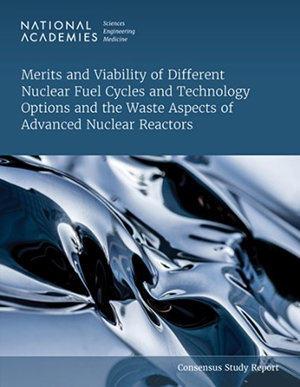News Archive
 The new report "Merits and Viability of Different Nuclear Fuel Cycles and Technology Options and the Waste Aspects of Advanced Nuclear Reactors" has been published by the National Academies of Sciences, Engineering, and Medicine.
The new report "Merits and Viability of Different Nuclear Fuel Cycles and Technology Options and the Waste Aspects of Advanced Nuclear Reactors" has been published by the National Academies of Sciences, Engineering, and Medicine.
A number of advanced reactors concepts and designs are under various stages of development worldwide and could hold promise to augment, or potentially replace, the current US fleet of commercial reactors, nearly all of which will reach the end of their currently licensed operating lives by 2050. The US fleet consists entirely of light water reactors (LWRs) operating with low-enriched uranium (LEU) oxide fuel in a once-through fuel cycle. Developers of advanced reactors and associated fuel cycles claim several advantages of their designs, including greater economic competitiveness, reduced environmental impact via better natural resource utilization and/or lower waste generation, and enhanced nuclear safety and proliferation resistance.
Conducted at the request of Congress, this report reviews the merits and viability, waste management aspects, and potential nonproliferation implications and security risks of fuel cycles for currently proposed advanced reactor designs. The report concludes that there are tradeoffs to consider among proposed advanced technologies, and no single concept can concurrently provide for all the potential benefits relevant to the scope of this study. Implementing just a few of the most promising concepts at commercial scale would require substantial investments by government and industry well beyond 2050. Most importantly, advanced reactors would not eliminate the requirement for geologic repositories for some radioactive wastes because there will still be a need to dispose of radioactive fission products. To move forward, Congress should establish a single-mission entity with responsibility for managing and disposing of the commercial nuclear waste. Among its attributes, the entity will need continuity of leadership and funding, a consistent disposal strategy, and the ability to lead research programs and large construction projects.
The report can be found on the National Academies website.




